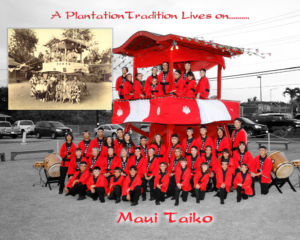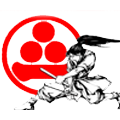About Taiko
HISTORY
In ancient times, taiko was used throughout Japan to signal activities in a village. Boundaries were established within earshot of the village taiko. Commands and movements on the battlefield were coordinated through the use of taiko. The most common utilization of taiko was for religious and cultural purposes. Taiko was used in gagaku or imperial court music, at Shinto shrines and Buddhist temples, ceremonial rites during festivals and Obon festivals.
Taiko in the form of a performing art originated in the early 1950’s in Japan. Jazz drummer Daihachi Oguchi created ensemble drumming or kumidaiko by arranging music for a group of performers playing on multiple drums. Oguchi’s group, Osuwa Daiko, started performing in 1951. Several years later in 1959, other well-known performing artists formed Yushima Tenjin Sukeroku Daiko and its offshoot, Oedo Sukeroku Daiko. The dynamic performing style of the Sukeroku groups, including the slanted drum stand, has influenced many taiko groups.
Taiko in the form of a performing art originated in the early 1950’s in Japan. Jazz drummer Daihachi Oguchi created ensemble drumming or kumidaiko by arranging music for a group of performers playing on multiple drums. Oguchi’s group, Osuwa Daiko, started performing in 1951. Several years later in 1959, other well-known performing artists formed Yushima Tenjin Sukeroku Daiko and its offshoot, Oedo Sukeroku Daiko. The dynamic performing style of the Sukeroku groups, including the slanted drum stand, has influenced many taiko groups.
The founding of three American taiko groups in the late 1960’s and early 1970’s greatly influenced the growth of taiko in North America. Kumidaiko made its way to the United States with the founding of San Francisco Taiko Dojo by Seiichi Tanaka in 1968. Tanaka studied with Osuwa Daiko and Oedo Sukeroku Daiko, introduced many people to the art form, and is considered the father of North American taiko. A year later, Kinnara Taiko, a Japanese-American Buddhist taiko group with its roots in festival drumming was formed in Los Angeles. Kinnara Taiko developed techniques to build taiko out of oak wine barrels, allowing groups to acquire reasonably-priced instruments. San Jose Taiko was established in 1973. San Jose Taiko has enhanced the art form by incorporating traditional Japanese and world rhythms in its music, and blending dance and movement in its performances.
TAIKO GROUPS
NORTH AMERICAN TAIKO CONFERENCE REGIONIAL
2020 – TCA in response to the pandemic, conducts a risk assessment and determines that NATC 2021 and NATC 2023 cannot happen. We pivot to digital conference and programs.
2021 – TCA begins to realize that we can do a better job serving our various regions of taiko through our programming.
2022 – TCA hires its second ED and works to create new strategic framework that:
Offers annual gatherings versus every few years, and
Incorporates a region-focused gathering (NATC-R) to our lineup. Town hall sessions and RFP (request for proposals) were conducted to identify the next few years of hosts for the return of NATC and the launch of NATC-R
More Information at: https://www.taikosource.org/home

Fukushima Ondo
Japanese immigrants from Fukushima Prefecture brought the song “Fukushima Ondo” to Maui in the early 1900‘s. Many of the immigrants lived in the plantation village of Keahua and organized an informal group to play Fukushima Ondo for the annual O-Bon festival. In the “good old days”, the group played the song for hours and people danced from sunset to early morning. Friends, relatives, and visitors of all ages, nationalities, and religions came to attend this annual festival.
Over the years, Maui Taiko founding member Kay Fukumoto has taught Fukushima Ondo to numerous taiko groups to include Mid-West Buddhist Taiko in Chicago (Illinois) , Denver Taiko (Colorado), San Jose Taiko (California), Las Vegas Kaminari Taiko (Nevada), Seattle Regional Taiko Groups (Washington), Genki Spark from Boston (Massachusetts) , Willamette University Taiko in Salem (Oregon), Phoenix area taiko groups (Arizona) and Odaiko Sonora from Tucson (Arizona). Mitchell Fukumoto, Kay‘s son now residing in northern California, also consulted and taught Fukushima Ondo to taiko groups at Mountain View Buddhist Church and Palo Alto Buddhist Church to perform at their local Obon festivities.
For more information on Fukushima Ondo, send us an email.
